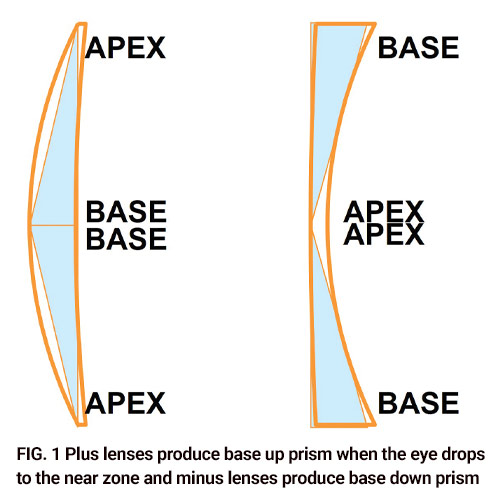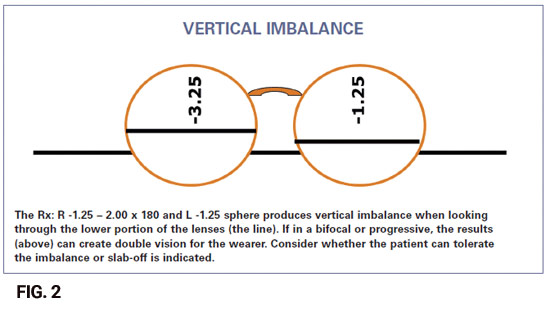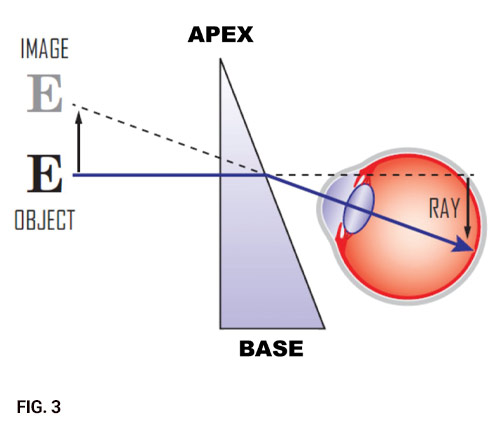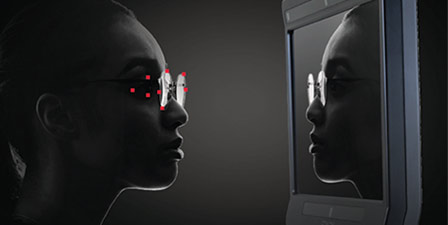Sponsored by IOT
By Deborah Kotob, ABOM
Slab-off prism balances or compensates for vertical prism differences between right and left lenses in the lower lens in multifocal eyeglasses worn by patients with anisometropia or antimetropia.
Why vertical? In multifocal eyeglasses, a slab-off prism is commonly used to correct a vertical prism imbalance between the right and left lenses for near vision. Single vision lenses do not require the wearer to drop their eyes in the lens to read, so they can simply move their head to keep the visual and optical axes in alignment. There is no prism in effect at the lens’ optical axis. With multifocal lenses, the eyes are forced to drop down in the lens to read, and therefore the patient’s visual axis is no longer aligned with the lens’ optical axis (Fig. 1).

Vertical prism imbalance happens when a significant difference in refractive power between right and left lenses results in unequal displacement of images formed on the retinae (Fig. 2). The brain must fuse the mirror images from the right and left retinae. Slab off helps with fusion of near object images because it balances their vertical position through the lens of each eye. Vertical prism is induced in spectacles due to the decentration from the optical center (or prism reference point in case of progressives) when the eye’s visual axis moves vertically from the lens optical center to the reading zone of a multifocal lens. The higher the power and the further the distance from the lens optical center, the greater the prismatic effects. When there is a significant difference in the degree of prism experienced by the right and left eyes due to a substantial Rx difference, the result can be a significant vertical prism imbalance that can cause discomfort to the patient and ultimately double vision for near objects.

Vertical prism imbalance between lenses causes the left and right retinae to form and transmit unequal images to the brain. Our brains are designed to fuse the two mirror images received from the right and left retinae into one clear image. To accomplish this, the left and right retinal images received by the brain must be similar, meaning that both eyes detect the object in the exact location (space) and time. When there are large differences in lens power, and the eye is looking down in a lens, vertical prism is encountered. If the amount of prism is equal in both eyes, all is well, and the brain receives similar images. Inversely, when the lens powers are significantly different, the brain will not be able to fuse the two images into one clear image.
What causes vertical imbalance in eyeglasses? Anisometropia (unequal refractive power) and antimetropia (opposite refractive power) cause several problems for the eyeglass wearer. As the eye looks through a lens’ visual axis, a.k.a. optical center, no prism exists; therefore, there is no image displacement. The further the eye rotates and moves away from the lens’ optical axis, the more prismatic effect occurs, resulting in image displacement (Fig. 3). If the amount of displacement is equal, then there is no problem, but the unequal displacement of images between right and left lenses in anisometropia patients causes diplopia, which makes fusion difficult. Potential symptoms of uncompensated vertical prism imbalance can include blur, diplopia, eyestrain and headache. Vertical prism imbalance is the the difference in prismatic effect at corresponding points away from the optical centers on a pair of lenses in the 90th meridian. Once the power for each lens is determined at the 90th meridian, then Prentice Rule is used to calculate the prism in each lens at the corresponding distance from the optical center to the near vision points (Power x Distance in cm). When a lens has cylinder power the oblique cylinder formula is used to find the spherical equivalent power in the 90th meridian.

Traditional slab-off or bi-centric grinding is when a base-up prism is ground into the lower half of the most minus lens in a pair of eyeglasses. Traditional slab-off requires a great deal of skill, so precast slab-off lens blanks that used reverse slab-off with base down prism molded on the front of the most plus lens were introduced. With the precast slab-off blanks, the prescription could be surfaced normally from the back. Now, in the age of free-from digital lenses, IOT Slab Off Calculation can produce the most precise slab-off prism to minimize vertical imbalance caused by the unequal prismatic effects as the eye’s visual axis moves down from the lens’ optical axis.
Correcting vertical imbalance in spectacles, particularly for the progressive lens wearer, is complex. The advanced technology behind the IOT Slab Off Calculation for Free-Form Progressives has an enormous benefit, providing the best correction in the anisometropic patients’ eyeglasses.












